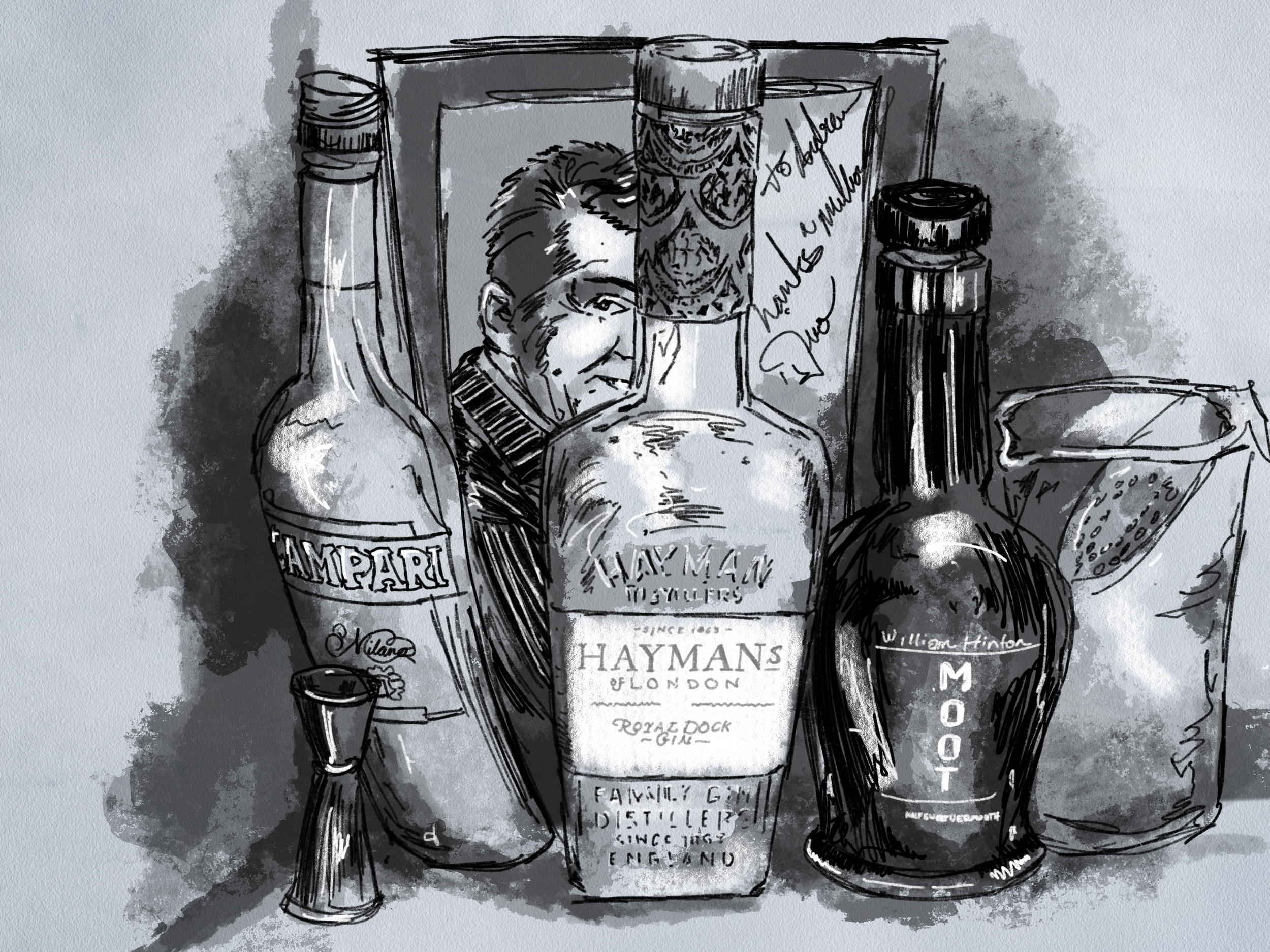I held a man’s hand on a plane one time, he was a stranger to me then and still is today. He was Bollywood handsome and his teeth were like flashbulbs blinding me when he spoke. “I’m a nervous flyer,” he said and I quickly offered, “maybe don’t look out the window.” I asked him where he was going and he told me about the cosmetic surgeons’ convention he was attending. As I asked him more questions and he babbled, I offered him my hand, and he took it. I reminded him “don’t look out the window.” So I was miscast in this romcom, holding hands with an Adonic doctor. Like 99.9999999% of all planes, we landed, he wiped off his sweaty mitts, and we departed without further words. A true story about me, a nice guy, helping a stranger, it’s who I am. I am a nice person. But I’m an asshole when it comes to gin.
I’m like a gin bigot, a real Sam Alito, an intellectually lazy asshole masquerading as an “originalist.” I’m like “there are at least, um, three or four perfect gins, why would anyone need a fifth brand?” “You put lavender, rhubarb, or lion’s mane mushrooms in the gin” and I start saying “the neighborhood is really changing.” What I deplore in how bigots treat others in our world is how I treat gin in the cocktail world. Why would I do this to myself and moreover, why am I so very wrong? It’s because I view gin as this thing I use for cocktails, a stalwart constant, a gesso for my canvass. I force gin to make the art rather than be the art. That’s kinda bullshit, but so are a lot of contemporary gins.
Let me do something I never do: explain a metaphor. I do think of gin as gesso for a cocktail’s canvas. Gesso is a mix of pigment (usually white, chalk, gypsum, and some (glue-like) binder used to prep a surface (usually canvas) for paint (often oil). If you paint on a canvas that hasn’t been gessoed, it will absorb paint in odd ways, messing up the saturation, and being subtractive to your pigments. If I’m making a classic cocktail or variant of a classic cocktail, I reach for a higher-proof, basic-botanical-profile gin. When a basic gin is made well, the world of aroma and flavor is contained in the bottle. Juniper itself is already so complex, it’s all you need to begin building a cocktail. There is no finer proof of this than Xoriguer Gin de Mahón, the signature gin of Menorca. The flavor and aroma spin your head, such vivid citrus, crisp alpine juniper, and oily earthy bass notes, what botanical recipe could possibly be so perfect? Xoriguer has only three ingredients: water, spirit, and juniper. Yet (deserved) rave reviews sing about its unknowable complexity and delightful perfection.
A note from the importer. p.s. it’s your real friends that don’t let your generalizing stand, thanks Raj
I won’t make you put on hip waders and slog through gin history. But I will remind you that many of the brands that you know were extant at the start of London Dry Gin. Beefeater, Gordon’s Gilbey’s, Boodles,* Seagram’s, and Tanqueray are all brands with a history of 140 years or more. They are all youngsters compared to Plymouth Gin. Collectively, these seven brands only use 22 botanicals, all share juniper (duh) and happen to feature angelica root. The remaining 20 botanicals used can make 1,048,575 unique combinations. And that’s without changing proof, base spirit, or different ratios of those botanicals if you counted those things, well, because I’m bad at math but I’m a shining golden god at hyperbole, so I’ll just say would that make the possibilities as infinite all time and space in there entire universe ever. I think those infinite possibilities being used for cocktails make my mind stall and reach for comfort I can fully understand. You might remember last week when I was stressing the need to "push around the edges" instead of just relying on the comfort of the expected. It happens to me too.
I have this conservative and reductive point of view that makes gin into a journeyman spirit. Different and more creative gins offer subtlety and nuance that I’m always asking for out of vermouth, or bitters, or just practicing better cocktail techniques. But gin has a limited job description at my house: Spanish style Gin & Tonic in the summer, Negroni while cooking dinner, and two Martinis with a Roger Moore Bond flick when Michelle is out of town. The bottle of Hayman’s Royal Dock Gin stands at attention on my bar, “stiff upper lip boys,” he says to the garishly bright red Italian (Campari) and stout mysterious Portuguese (Moot, a Madeira-based vermouth). Yes, he stands there, voiced by Ralph Fiennes perhaps, just a “stout fella who keeps muddling through.” He’s fine with his extremely narrow orders, blinders on to the rogues’ gallery of whiskies in the steamer trunk across the room or the Mos Eisley Cantina drawer of liqueurs directly under him. Those other locations in my house get to party, they’ve got stories, maybe they've done a little time in jail but not the gin. Now that I’m behind the bar again, I’m reminded of reasons to even have a secondary or **gasps** tertiary bottle of gin.
Dean Martin watches over my bar
I’ve been trying to avoid talking shit about brands but I can wait no longer. I had an Aviation Gin Martini a month ago and I’m still not over it. It was as soothing as sandpaper sheets. Aviation Gin is not bad and folks have been mean to it since 2006 and yet Aviation seems to be doing just fine. You could even say they invented a new spirits category. New American Gins have calmed down and improved. But having tended bar, been a brand owner, and a spirits distributor during the era of “enfants terribles distillatuers” who bombarded us all with “a hot new take on gin” based on the flavors they experienced on “a backpacking trip they took through a small village named white privilege,” eh, maybe I lost some tolerance for “innovation.” Sometimes new gins are replicas of old recipes that change one thing and then pour the juice into a fancy bottle. Sometimes these new gins are just rotgut vodka compounded with juniper oil that swapped out the humble bathtub of prohibition for a huge marketing budget… and a fancy bottle. Equally offensive are low-flavor-80-proof-fly-by-night UK gins seemingly created to nudge vodka out of the way for Barcelona-bound tourists often identified by being in fancy bottles. But back to that Aviation Martini. A Martini is intimate, I can’t tell you how you want yours, but this lavender and sassafras jam ain’t it for me. Whereas my “Mr. Keep Calm and Carry On” gin bottle has the same answer for everything: juniper, Aviation can be much more adaptable, it can answer questions in full sentences. I love it with grapefruit, it’s got a strong herbal backbone that’ll really hold a Last Word Cocktail together, and it’d be one of the first gins I’d reach for if I were making up a stronger amaro cocktail. It’s not easy to be a gin distiller. It seems all I (and many others) have to offer is backhanded compliments,*** but there is a lot of room out there to have a unique thesis and/or expand smaller gin categories. There is so much Navy Strength Gin out there now, a wealth of flammable booze.
For another example, melon gin is a thing now? There are a half dozen on the market. Again, I want those melon gins in a Martini like want to replace chocolate chips with chunks of shoe polish. But OMGSTFU those tutti frutti gins are they great in a Corpse Reviver #2, Ramos Gin Fizz, or in an old “classy” version of a Midori Sour I used to make. I was re-tasting gins I know well at work, you know, for my job. I was also preparing to write this and Keith (new boss/ old friend) slaps a bottle of Sông Cái Vietnam Floral Gin in front of me and to continue my hyperbole spaceship, I saw the third monolith at Jupiter and got sucked into the Star Gate and experienced things a human can’t understand. I thought it was very good. It made me want to use gin for something new, maybe something other than a Negroni, a Martini, or a Gin & Tonic. Sông Cái reminded me that my journey shouldn’t be over with gin and that the enjoyable sides of infinite possibilities exist too. I shared my new gin friend with a guest last night, that guy took out his phone to take notes, and the whole nine, he was inspired too. We just started with a Gin & Tonic but I was relieved to find a gin like Pete Seeger’s banjo: “this machine surrounds hate and forces it to surrender.” Only accepting a limited definition of gin was making me the “hate” and I’d rather be the “machine.”
Next week: Bohrer’s Hierarchy of Negroni
*Gin brands, man, you gotta triple check your apostrophes
**Royal Dock is a favorite of mine. At 57% alcohol by volume, you’ll always know you are having a gin cocktail. I love it in a Gin & Tonic with Royal Dock because I can use an ounce or so to six ounces of tonic and still have a light, effervescent highball. If I use a 40% ABV gin I’ll use about two parts gin to three parts tonic— a highball with the effervescence of a burp.
***I will make a commitment to making a list of “gins I like that aren’t available at Target, Costco, or grocery stores, but you must commit to special ordering them


